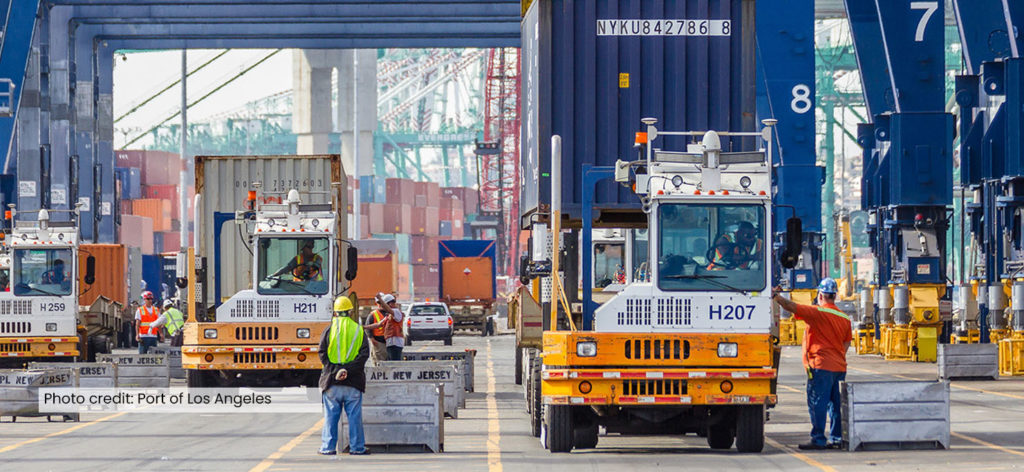Local 13 of the International Longshore and Warehouse Union (ILWU) and the Pacific Maritime Association (PMA), which represents terminal operators and shipping lines, have come to an agreement involving manning requirements for cargo-handling equipment at conventional container terminals in Los Angeles-Long Beach, sources report.
With this development, a major hurdle has been overcome as it could speed up the process of agreeing on a new coastwide contract. Negotiations are closing in on the one-year anniversary of their May 10, 2022 start.
The two sides had already reached agreement on manning needs at the three automated terminals in Southern California several weeks ago. Coastwide negotiations in San Francisco will now shift to the two major issues yet to be settled — wages and pension benefits.
Sources close to the coastwide negotiations express optimism that a tentative agreement could be reached in the next couple of weeks.
Once a tentative coastwide agreement is reached, ILWU locals along the West Coast will wrap up discussions on remaining issues at their ports. The entire coastwide agreement will then be distributed to the ILWU membership for review. Next, discussions will take place between ILWU local officers and members before they vote on it.
According to sources, the process will take several weeks. A ratification vote could materialize in mid-summer, assuming a deal is struck soon.
Source: Journal of Commerce
Air Cargo Demand Fell Below pre-COVID Levels in March

Global air cargo demand, measured in cargo tonne kilometers (CTK), fell -7.7% in March year-on-year (y/y), according to IATA data. However, this was an improvement over February’s performance and at half the annual decline rate recorded in January and December. “At this point, it is unclear if this is a potentially modest start of an improvement trend or the upside of market volatility,” IATA said.
The addition of belly capacity as the passenger side of the business recovers raised capacity (measured in available cargo tonne-kilometers, ACTK) by 9.9% compared to March 2022. Cargo load factors in March slipped -8.8 percentage points from a year ago to 46.2%.
The global new export orders component of the manufacturing Purchasing Managers’ Index (PMI), an indicator of cargo demand and for China, has fallen below the 50-mark, pointing to declining confidence. There are also indications of high inventory levels, which tend to impact air cargo negatively.
Although IATA’s director general, Willie Walsh, noted most indicators for the fundamental drivers of air cargo demand are weak or weakening, he pointed out some positive developments. “While the trading environment is tough, there is some good news. Airlines are getting help in managing through the volatility with yields that have remained high and fuel prices that have moderated from exceptionally high levels. Looking ahead, with inflation reducing in G7 countries policymakers are expected to ease economic cooling measures and that would stimulate demand,” he said.
Source: Air Cargo News
EU ETS: “Every Player in the Value Chain will Need to get Involved”
The implementation of Europe’s Emissions Trading System (ETS) raises the question of how costs incurred to meet the regulation will be added into contracts between those in the shipping value chain.
To establish a starting point for compliance with ETS, a year’s worth of CO2 data has to be collected. Shipping will use 2024 as the first reporting year under the ETS. The collected data will determine emissions liabilities that will translate into EU emission allowances (EUA), also known as carbon credits.
The shipping industry will be financially exposed as soon as emissions start being collected from Jan. 1, 2024. “One ton of CO2 translates to one emission allowance that needs to be bought or acquired somehow, and today, that one EUA would cost you around 100 euros [$110],” Eirik Nyhus, director of environment at DNV told attendees at a recent webinar hosted by the classification society. “When you look at what those numbers mean for shipping, you’re looking at roughly $10 billion per year at that price level by 2026 when we have full effectiveness of the regulation,” he added.
The ETS system requires shipping to pay for allowances covering 40% of greenhouse gas (GHG) emissions in 2024, rising to 70% in 2025 and 100% from 2026. The ETS applies to cargo and passenger ships above 5,000 gt from 2024 and offshore ships above 5,000 gt from 2027. It will initially cover CO2 emissions and then be widened to include methane and nitrous oxide from 2026. All emissions on voyages and port calls within the European Union and the European Economic Area, and 50% of emissions on voyages into or out of Europe, are subject to the ETS.
Pål Berg Lande, digital business development director at DNV, said a large part of the maritime industry was not prepared for the impact of the ETS. “The industry can be divided into various key players such as ship managers, owners, operators and cargo owners,” he told webinar attendees. “Today, ship managers mostly handle emissions management for compliance purposes, however, moving forward, every player in the value chain will need to get involved.”
Nyhus pointed out shipping’s inclusion in the ETS was just eight months away and those in the maritime value chain had to be ready to manage the regulation.
Source: Journal of Commerce
North Asia’s Factories Stuck in Decline
North Asia’s factories have reported contracting activity in April, according to surveys published by S&P Global, adding to concerns about the risk of a global recession.
The manufacturing purchasing managers’ index for South Korea and Taiwan registered readings at 48.1 and 47.1, respectively, indicating contracting activity. “There were reports that weak demand conditions, particularly across key export markets such as the U.S., Europe and mainland China, continued to act as a drag on performance,” noted Annabel Fiddes, economics associate director at S&P Global Market Intelligence.

The readings contrasted those in Southeast Asia with Thailand, leading the region with a PMI of 60.4, while Indonesia and the Philippines remained above 50.
Persistent inflation and increased borrowing have weakened world trade, lowering the demand for exports, including critical commodities and consumer goods like electronics. An official survey detailing the unexpected contracting of Chinese manufacturing activity in April has raised questions about the speed of recovery for the world’s second-largest economy. Much of Asia is relying on China to create much-needed momentum, particularly for the services industry, as the economy restarts travel, construction, and investment.
Source: American Journal of Transportation
Cambodia’s Port Construction will Triple Container Handling Capacity by 2029

Cambodia, one of the region’s fastest-growing economies, has started construction on a new container terminal at Sihanoukville Autonomous Port. The port is expected to be a major artery for Cambodia’s maritime transport.
“The expansion project will allow large container ships to dock at the port and significantly reduce ocean freight costs for Cambodia,” Cambodian Prime Minister Hun Sen said at the ground-breaking ceremony on May 5th.
The new terminal would be built in three phases, according to Cambodia’s Minister of Public Works and Transport, Sun Chanthol. The first phase includes the construction of a 350 m long and 14.5 m deep container terminal, allowing ships of up to 4,000 teu to call. The second and third phases will commence in 2025 and 2026, and would conclude in 2028 and 2029. Upon completion of all three phases, the port will be able to process 2.58m TEU a year.
Source: splash247.com
Conflict in Asia will Hurt Container Trade Warns Singapore’s Minister of Defence
Speaking at the 13th International Maritime Defense Exhibition and Conference Asia in Singapore, Dr Ng Eng Hen, Singapore’s Defense Minister warned that war in the region would impact container shipping and called on China and its neighbors to maintain a rules-based order to guide interactions in the maritime domain.
“Thirty percent of the world’s seaborne trade passes through the South China Sea each year,” he said. “One quarter of global oil trade and one third of global container trade passes through the Straits of Malacca and Singapore. We sit astride a key sea line of communication, and if conflict were to destabilize our region, it would have far-reaching implications.”
Ng noted China is a major manufacturer of essential goods and had a significant role to play. “The world is dependent on China as a major manufacturer for sundry goods and many essentials. No transactional global challenge can be dealt with without China’s input,” he pointed out. He said that with Russia’s invasion of Ukraine now in its 15th month, the world cannot afford a concurrent war in Asia.
Source: The Loadstar




